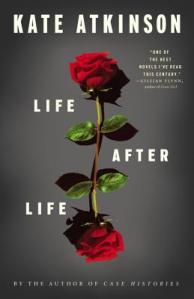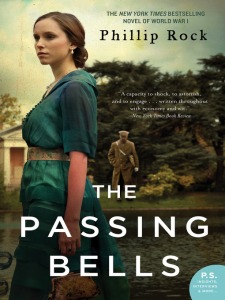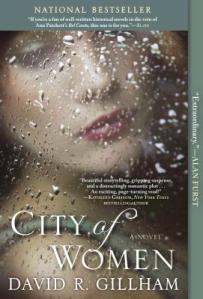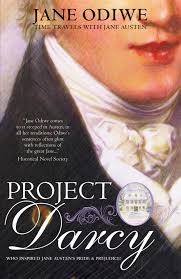I managed to read 102 books in 2013, which is amazing given how busy I’ve been the last few months visiting high schools and filling out applications and financial aid forms for The Girl. With everything due in December, right around the holidays, I’ve been exhausted. So I’m not surprised that I didn’t top the 114 books I read in 2012 and that I was two books short of finishing all the challenges in which I participated. But I’m thankful that I had reading time at all, and I read so many good books in 2013 that narrowing them down was really difficult. So here’s my list of favorites, keeping in mind that all of them were read in 2013 but not necessarily published that year.
My Top 10 of 2013
 Life After Life by Kate Atkinson
Life After Life by Kate Atkinson
(from my review) Life After Life is a beautifully crafted novel whose impact on me has not lessened in the weeks since I finished it. Atkinson has created an amazing character in Ursula — someone so ordinary and so endearing yet called to something too big for us to wrap our minds around. If I hadn’t grown to care for her, to cheer her on every time she struggled through another life, and if Atkinson had not set the book in such a fascinating time period, it might have grown as tedious as the title sounds. But in Atkinson’s skilled hands, Ursula and her story (gift? plight?) will not be easily forgotten.
 The English German Girl by Jake Wallis Simons
The English German Girl by Jake Wallis Simons
(from my review) The English German Girl is one of those books that leaves you speechless when you turn the last page and haunts you for weeks afterward. It’s also one of the best World War II novels I’ve read depicting the struggles of Jews living in Germany as Hitler and the Nazis come to power. … Beautifully written, with rich details and unforgettable characters, The English German Girl is a powerful novel about how war brings people together and tears them apart, how far people are willing to go to save the ones they love, and finding hope among the horrors, love among the ruins, and the strength to keep going. I was blown away by Simons’ storytelling, how he made me feel as though I was actually in prewar Berlin and wartime London, walking alongside characters who felt real, like I knew them as well as I know myself.
 Rising Sun, Falling Shadow by Daniel Kalla
Rising Sun, Falling Shadow by Daniel Kalla
(from my review) Rising Sun, Falling Shadow is an exciting novel, with Kalla showing the danger and chaos from the very first page. Kalla is a fantastic storyteller, making wartime Shanghai come to life. I could see how the once vibrant city had begun to deteriorate, feel the fear and hunger and never-ending anxiety and uneasiness of the refugees, and sense the danger lurking everywhere. … With complex and memorable characters struggling with anger and guilt and simply trying to survive, Rising Sun, Falling Shadow is an emotional story about how far people will go to save those they love. Kalla provides enough back story for the novel to stand on its own, but I recommend reading them in order to appreciate the evolution of the characters and the changes the city undergoes as the war drags on. The novel is not only a page-turner but also a thought-provoking tale of love and loss, courage and betrayal, and the search for humanity amidst so much wretchedness.
 Looking for Me by Beth Hoffman
Looking for Me by Beth Hoffman
(from my review) Looking for Me is one of those books you know you’re going to love from the very first page. Beth Hoffman is such a talented storyteller, and I’ve loved her writing since I read Saving CeeCee Honeycutt (which made my Best of 2010 list). Her characters are so well developed and so real, and her descriptions are so vivid and rich that you feel like you are walking alongside the characters. The best way to describe Hoffman’s writing is warm and insightful, and this book just spoke to me. … I love how Hoffman can take you on an emotional roller coaster ride (I teared up reading this on the train and didn’t care if anyone noticed), and even when you feel wrung out and breathless like the characters, you can’t help but enjoy it and want more. She writes about a family broken by a tragic event, and she does so with heart and even hope. Looking for Me is such a rich novel, with delicious descriptions of antiques and a portrait of the power of nature, the unbreakable bond of close siblings, and the freedom that comes from accepting the past while looking forward to the future.
 The Crooked Branch by Jeanine Cummins
The Crooked Branch by Jeanine Cummins
(from my review) Normally when I read a novel that weaves together the past and the present, I find myself drawn to the historical story and think the present-day story is just so-so. But this time around, I was equally captivated. … The Crooked Branch is a story with motherhood at its core, how parenting comes with its ups and downs, no matter the time or place. Majella’s problems may seem insignificant in comparison to Ginny’s, but her fears and inner turmoil are authentic. Cummins paints a picture of two women willing to do anything to protect their children and addresses the issue of heritage and one’s identity after becoming a mother. It’s a tale of mothers and daughters — Majella and the mother she feels she never knew, and Ginny and Maire, who was forced to grow up too soon. Cummins’ prose flows so beautifully that it’s easy to get lost in the story and breeze through a whole chunk of pages without even realizing it. The connections between the past and the present are satisfying, and the characters are so fascinating that I didn’t want the novel to end.
 The Passing Bells, Circles of Time, and A Future Arrived by Phillip Rock
The Passing Bells, Circles of Time, and A Future Arrived by Phillip Rock
(I know I’m cheating with a trilogy, but these books span both world wars and must be read together!)
(from my review of The Passing Bells) The Passing Bells is truly an epic novel of the “war to end all wars” that shows how the war ushered in change on all levels. Rock’s characters were so tenderly crafted and so wonderfully complex that I could understand them all even when I didn’t like them. Their relationships and entanglements felt true to the chaos of the time, and the battle scenes had just the right amount of description to emphasize the horror and the confusion without going overboard on the violence or the military maneuvering.
(from my review of Circles of Time) Rock was a fantastic writer, bringing the post-World War I landscape to life, all the chaos and the change, and letting readers tag along while the characters they have grown to love evolve with the times. Even while the world is swiftly moving forward, Rock doesn’t let readers forget about the massive loss of life, the destruction of the landscape, and the veterans with missing limbs or shell shock left behind by the Great War.
(from my review of A Future Arrived) A Future Arrived was a difficult book to put down, but at the same time, I didn’t want to rush through it because I knew I was going to have a hard time letting these characters go. Although I longed for more time with the characters I’d grown to love since the first book, I understood the need for the torch to be passed and to view the wartime struggles from the eyes of the characters at the forefront. At the same time, Rock also shows how those who remember the Great War deal with the prospect of another, and he continues to shine a light on social class, sexuality, and the role of women, which changed so much in response to WWI. The scope of this trilogy is so big, so ambitious, yet focusing on one family navigating the changes brought by two wars makes it manageable.
 The Revolution of Every Day by Cari Luna
The Revolution of Every Day by Cari Luna
(from my review) The Revolution of Every Day is gritty and raw, yet carefully composed and beautifully written. Luna doesn’t portray squatting as right or wrong, but she gets readers thinking about why people would take such a risk for a chance to create a home of their own in an exciting and vibrant city. Her love for the city of her birth shines through as she describes the promise it once held and a sense of loss as money ushers in change. Most importantly, Luna shows how revolutions are grounded in the every day and how struggles within a community and within friendships and romantic relationships affect and even transcend the larger movement. Luna’s prose is detailed and insightful, and The Revolution of Every Day is a thought-provoking page-turner with unique characters whose strength and passion will not be easily forgotten.
 Every Man Dies Alone by Hans Fallada
Every Man Dies Alone by Hans Fallada
(from my review) Every Man Dies Alone is a powerful book, one I won’t easily forget. It was easy to see where the story was headed, but there were plenty of twists and turns to keep it from being too predictable. It’s one of only a few books that have affected me so deeply that, after turning the last page, I could do nothing but sit and stare and ponder what it all meant. Reading the bonus features about Fallada’s difficult life, especially how the Nazis stifled his creativity, and the true story behind the book made for a richer reading experience. Every Man Dies Alone is an important novel, and I fear I didn’t do it justice here. I urge you to give this one a try, so long as you don’t mind a story that plunges you into the depths of evil and despair but also leaves you with a better understanding of what it was like to live in Nazi Germany.
 City of Women by David R. Gillham
City of Women by David R. Gillham
(from my review) City of Women was both difficult to read and difficult to put down. Gillham focuses on a flawed woman who had grown so used to ignoring the atrocities being committed around her that she can’t help but be completely changed when she is forced to act. It’s a novel that really underscores how easy it is to grow complacent, to do nothing, to lose oneself in the routines of everyday life. Sigrid is far from perfect, but readers will recognize a little of themselves in her, making it easier to understand her choices. And life-or-death choices must be made over and over during the course of the novel. Gillham forces readers to think about how they would have behaved in Sigrid’s shoes, how far passion can drive someone to act, and how love and duty affect our decisions. A highly recommended portrait of fear and longing, with rich prose that highlights the darkness of war and the freedom that comes from finding one’s true self.
 The Last Telegram by Liz Trenow
The Last Telegram by Liz Trenow
(from my review) I honestly can’t think of one thing I didn’t like about The Last Telegram. The romance between Lily and Stefan might seem like something that’s been done before in other WWII novels, but Trenow makes it different by incorporating the history of how the British government placed all men and boys age 16 and older with passports from enemy countries in internment camps. … The Last Telegram is a story about love and loss, guilt and forgiveness, and although it made me cry, Trenow does a good job balancing the sadness with hope. It’s a fast-paced novel that isn’t too heavy on the tragedy, but the love you feel for the characters and how Trenow transports you back in time, in their shoes, make for an emotional and completely captivating read.
The 2013 Honorable Mentions
I’ll Be Seeing You by Suzanne Hayes and Loretta Nyhan — The best epistolary novel set during World War II that I’ve read so far. With each author writing from the point of view of one of the heroines and trading letters via email without ever meeting in person, the novel has two distinct voices.
His Majesty’s Dragon by Naomi Novik — I never would have read this book if it wasn’t for my book club, and I would have missed out on a great fantasy novel set during the Napoleonic Wars. I never thought I could be so captivated by a talking dragon, but now I can’t wait to read the rest of the series.
Jack Absolute by C.C. Humphreys — A fantastic swashbuckling spy novel set during the Revolutionary War. Jack Absolute is a dashing, brave, charming, and completely unforgettable character.
If You Could Be Mine by Sara Farizan — This novel goes beyond the typical teenage love story by delving into the romance between two female best friends in Iran, where homosexuality is illegal and punishable by death. Farizan gives readers a glimpse of Iran’s underground gay community and shows the struggles endured by those who choose sex reassignment surgery, which is legal.
The Ghosts of Rue Dumaine by Alexandrea Weis — I’m very picky about romances, especially paranormal ones, but Weis is one of my favorite romance writers. I do enjoy a good ghost story, though, and coupled with Weis’ detailed and enticing descriptions of her native New Orleans, this one grabbed me from the very beginning.
What were the best books you read in 2013? Feel free to link to your lists in the comments, and I’ll be sure to check them out.
© 2014 Anna Horner of Diary of an Eccentric. All Rights Reserved. Please do not reproduce or republish content without permission.
Read Full Post »




 Life After Life
Life After Life The English German Girl
The English German Girl Rising Sun, Falling Shadow
Rising Sun, Falling Shadow Looking for Me
Looking for Me The Crooked Branch
The Crooked Branch The Passing Bells
The Passing Bells The Revolution of Every Day
The Revolution of Every Day Every Man Dies Alone
Every Man Dies Alone City of Women
City of Women







